sixty_reefer
5000 Club Member
View BadgesArticle Contributor
UK Reef Club Member
Hospitality Award
R2R Research
Got a lot to catch up lolYes exactly
didnt you block me?
Follow along with the video below to see how to install our site as a web app on your home screen.
Note: This feature may not be available in some browsers.
Got a lot to catch up lolYes exactly
didnt you block me?
That was a joke for @brandon429Got a lot to catch up lol
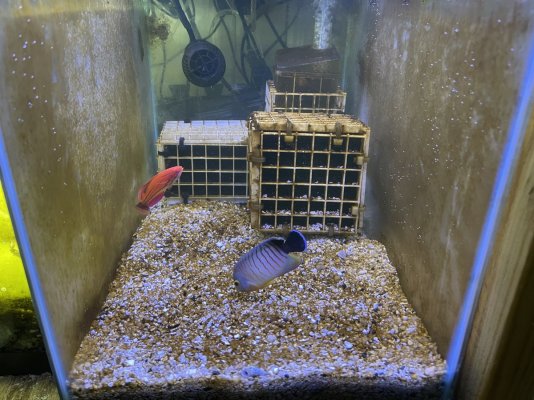
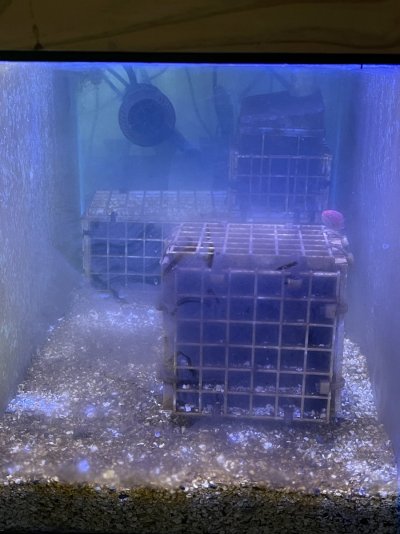
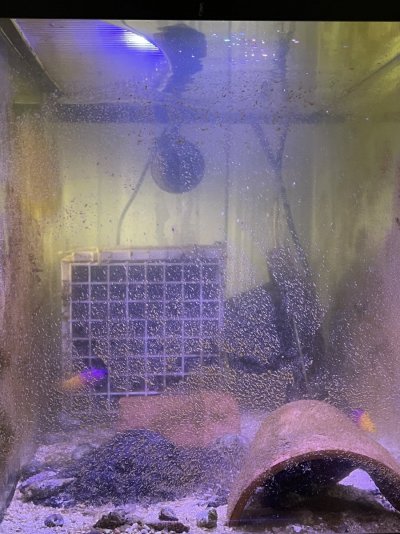
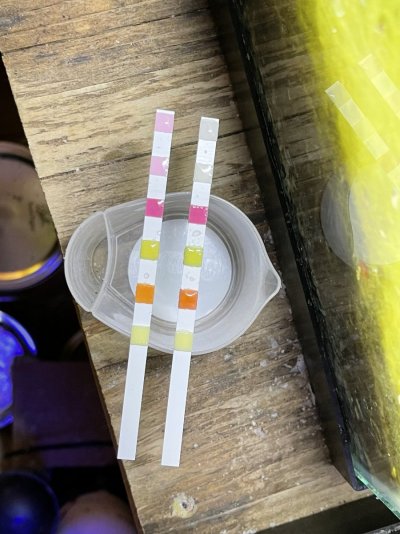
Questions:Here's a fun one for yall.
Here's 2 of my tanks that are now quarantine tanks. One tank I "rip cleaned". The other tank I didn't. In the not rip cleaned tank I have 3 royal gramma, but one died shortly after arriving. The other 2 are still doing pretty well. The rip cleaned tank I put my wrasse and angel fish into. Angel fish showing signs of ich. I have treated both tanks with the same meds and fed roughly the same amount of foods. After a couple days the cycle in the rip cleaned tank crashed. It's been several days now and my cycle still hasn't recovered. The cycle in the old tank hasn't skipped a beat yet. Don't even have high nitrates.

Couple days after rip clean

Rip cleaned tank now

Old tank no rip clean

Old tank reads no nitrites and no nitrates. Rip cleaned tank reading nitrites for at least 3 days now.
The rip clean did not work for me.
1) I used tap water to clean out the sand. Then I wanted to experiment with a diy plenum type of setup. So I put back some sand (chunky aragonite) back on top. I put back the same bcb basket which acts as my "rock" or beneficial bacteria bed.Questions:
1. Did you use Fresh (tap) or saltwater?
2. One problem is there is not a huge amount of surface area in either tank for bacteria. I assume you cleaned your sand, etc. Will tag @brandon429
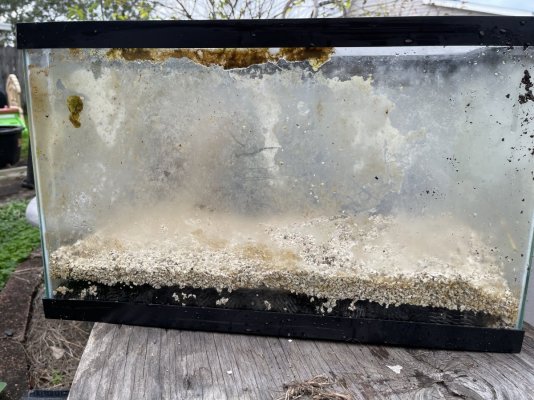
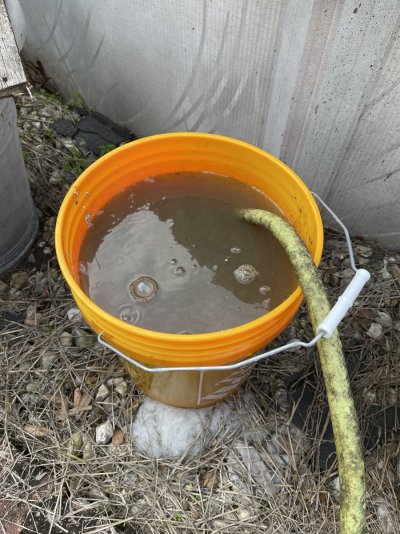
Right - Maybe @Dan_P can comment. Mine is that the blocks you are using do not have a large surface area - whereas your sand provided some. @taricha - I believe - has suggested that sand is quite important in nitrification based on experiments he has done. So - my comment would be (not meant as criticism) - when fish are in QT - they're stressed already - doing a rip-clean - probably could/should have waited until after? And Sorry about your fish.1) I used tap water to clean out the sand. Then I wanted to experiment with a diy plenum type of setup. So I put back some sand (chunky aragonite) back on top. I put back the same bcb basket which acts as my "rock" or beneficial bacteria bed.


2) not a lot of surface area but both tanks have about the same.
OH - and BTW - depending on what kind of tap water you have (chlorinated/Chloraminated (is that a word)? the experiments I've done above show a significant decrease in nitrification this was verified to various degrees by @Coxey81 and @sixty_reefer. So it might just have been too much - too quickly?Right - Maybe @Dan_P can comment. Mine is that the blocks you are using do not have a large surface area - whereas your sand provided some. @taricha - I believe - has suggested that sand is quite important in nitrification based on experiments he has done. So - my comment would be (not meant as criticism) - when fish are in QT - they're stressed already - doing a rip-clean - probably could/should have waited until after? And Sorry about your fish.
I have chloramines in my water. I understood the risks to doing a rip clean but according to our resident experts it should have had little effect. I really don't beleive that and Even I was surprised at how overwhelmed the tanks biofilter is though.OH - and BTW - depending on what kind of tap water you have (chlorinated/Chloraminated (is that a word)? the experiments I've done above show a significant decrease in nitrification this was verified to various degrees by @Coxey81 and @sixty_reefer. So it might just have been too much - too quickly?
Hard to make a call on this one. What was the time frame between rip cleaning and photos? Both aquaria have the appearance of being overgrown. Might the rip cleaning be incomplete? The appearance of nitrite certainly seems like a solid effect. I couldn’t tell from the picture how much nitrite was produced. Was it high?Right - Maybe @Dan_P can comment. Mine is that the blocks you are using do not have a large surface area - whereas your sand provided some. @taricha - I believe - has suggested that sand is quite important in nitrification based on experiments he has done. So - my comment would be (not meant as criticism) - when fish are in QT - they're stressed already - doing a rip-clean - probably could/should have waited until after? And Sorry about your fish.
Cool stuff. Following.Several people have been kind enough (@Coxey81 and @sixty_reefer) to do a couple experiments and comment (@Lasse, @Dan_P, @taricha) on the effects of freshwater and scrubbing live rock on nitrifying capacity (whether by bacteria, algae or both). These experiments are meant to repeat and extend those experiments.
Goals:
1. Validate (or not) the results of @Coxey81 - which showed that after freshwater scrub/rinse that the nitrifying ability of rock originally from a dark sump area in a cycled tank loses about 80% of ammonia removal after freshwater rinse and scrub.
2. Validate (or not) the results of @sixty_reefer - which showed that after freshwater soaking for multiple minutes affected the nitrifying ability as well - His rock was exposed to light, had algae, and was from a lit tank - but only lost about 50 % of ammonia removal capacity
3. Evaluate Nitrite, Nitrate as well. Evaluate changes in Phosphate during testing.
4. Is there a change in ammonia removing ability between using 'saltwater rinse and scrub' and 'freshwater rinse and scrub'.
5. EDIT - Try to determine whether the tank and equipment (without rock) contain significant nitrification ability (in the dark)
Tank Parameters:
1. 1 lb rock/gallon.
2. 78 degrees.
3. pH - constant based on where salt mixes with RODI. Using Brightwell Marine.
4. Flow via marineland powerhead.
5. Salinity at 1.026 - maintained with Top off as needed with RODI.
Experiment(s):
1. Repeat @Coxey81's experiment
Step 1. Set up tank, add rock to 1 lb (or so) per gallon, heat to 78 degrees. add powerhead. (rock has been in dark sump - high flow area for >5 years)
2. Add 4 drops Dr. Tims (per instructions - as Coxey did) - which resulted in a high ammonia level - but - according to Dr. Tim's instructions should not cause a problem.
3. See if ammonia is processed in 24 hours.
4. Repeat steps 2 and 3 until the ammonia is processed in 24 hours. IF repeated steps are needed I PLAN (Comments?) to dose water containing 2 ppm ammonia (measured before adding to tank)
5. Hereafter is where things will change (a little) - After the tank/rock can process 2 ppm ammonia in 24 hours (rinsed tank between uses) - will do the same RINSE (BUT IN SALTWATER) as @Coxey81 - which I believe was a soak in water, followed by scrubbing and rinsing for 1-3 minutes.
6. Then - I will again check to see if 2 ppm ammonia can be processed in 24 hours. If so - I will repeat step 5 - using FRESH water (tank temp) per the same protocol.
7. If after step 5 or 6, ammonia is not processed in 24 hours, will continue every 12 hour testing until it is processed.
8. At this point - re-verify if 2 ppm ammonia can be processed.
EDIT - 9. Then remove the rock, add 2 ppm ammonia and determine how long it will take to process ammonia.
After this I think I will take some old rock covered with various 'stuff' from the lit tank - and repeat the 2 experiments above - which will hopefully document @sixty_reefer's experiment.
I am going to try to borrow a seneye if possible.
I will use API tests to measure ammonia - along with another one. I will purchase 2 separate kits - to check for any errors.
I will also measure ammonia, nitrite, nitrate, pH daily or 2x day depending on where we are in the experiment.
po4 will be measured at the beginning and end of each experiment.
I cleaned the sand on December 18. Hard to say exactly how high nitrites are. I typically don't care as long as it's zero. And if I see nitrites I know I had ammonia so I don't really test for ammonia typically. Here's some new photos with a clean viewing panel. And pics of the tank after I cleaned it. Sorry not intended to hijack this but thought it was just relevant to the discussion.Hard to make a call on this one. What was the time frame between rip cleaning and photos? Both aquaria have the appearance of being overgrown. Might the rip cleaning be incomplete? The appearance of nitrite certainly seems like a solid effect. I couldn’t tell from the picture how much nitrite was produced. Was it high?
Experiment 12 , 24 hours after ammonia.Experiment 12:
Purpose - Ammonia removal after scrub and rinse with non-chlorinated fresh water.
Same setup:
1. 2 tanks - both dark now 1 with live rock from sump the other live rock from a display tank (lit)
2. Same HOB filter (with no media - only for oxygenation, same powerhead and heater in each tank.
3. 2 ppm Ammonia on Day 1 (today)



Experiment 12 results:Experiment 12 , 24 hours after ammonia.
1. The ammonia was not completely processed.
2. Once again Tank 2 is lagging behind tank 1 Slightly
3. Nitrite on this test remains 0.
4. IMPORTANT - This is the first time that the Seachem and API tests have not been 'the same'. I.e. in Tank 1, the Seachem alert says 'safe' and a clear yellow. The Alert in tank 2 is between safe and alert. You can see that the API test in tank 1 does not match.
Will replicate this again - in case I made some error, etc.


Tank 1 Ammonia

Tank 2 ammonia

Tank 1 Nitrite

A few rocks here and there makes no difference, I’ve nuked them with calcium/sodium hydroxide and in a mature(ish) system and they grow coralline like crazy, presumably from the magnesium precipitate. Love these experiments because it makes some of us think. There are those that don’t think, obviously. CudosI guess - based on all of the above - I would say - if I was going to do a 'rip-clean' of everything - I would use saltwater - as compared to tap. If I were cleaning a couple rocks - I would feel comfortable using tap.
This is going to come down to something @taricha discussed a couple months ago - how much nitrification comes from the sand - vs the rock.
I think you're absolutely correct - taking out all your sand - probably no problem. Taking out all your sand, and cleaning all your rocks, etc - probably going to be a problemA few rocks here and there makes no difference, I’ve nuked them with calcium/sodium hydroxide and in a mature(ish) system and they grow coralline like crazy, presumably from the magnesium precipitate. Love these experiments because it makes some of us think. There are those that don’t think, obviously. Cudos
Thanks for all your hard work!So I think these experiments are 'done'. I wanted to write a short review of (my) conclusions:
Purpose: To determine whether :
1. Established cycled rock (>5 years) from a dark sump and a lit display can process 2 ppm ammonia after 24 hours (using about 1.5 l bs rock/gallon water)
2. Assuming that rock does not immediately process 2 ppm, over time - can further processing capability develop.?
3. Does ammonia processing capability come from glass/filters, etc?
4. Does photosynthesis affect ammonia processing capabilities?
5. Does rinsing and scrubbing with Salt water, Tap water (1 ppm Chlorine), Dechlorinated tap water - affect ammonia processing capability. ?
6. Do API and Seachem alert tests give similar results?
7. What about 'Rip-Cleans'.
Background: Many reefers take out rock, clean it of algae, etc - and replace it - a so-called Rip-Clean. Experiments of @Coxey81 and @sixty_reefer showed that rock from a dark sump and a lit display (respectively). - could eventually process 2 ppm ammonia/24 hours - but not at first. And that Rinsing and scrubbing rock diminished the ammonia processing capability in both tanks.
Materials:
2x 5 gallon tanks identical heaters set to 78, identical HOB filters (no media), identical power heads. Approximately 5 lbs of rock. Approximately 4 gallons of water. Dr. Tim's ammonia.
Results: well documented in the thread
Conclusions;
1 and 2. Established live rock from a dark sump and a lit display process ammonia.
1a. Dr. Tim's ammonia if instructions are followed result in overdoses > 4 ppm
1b. Thus a syringe with a measured amount of ammonia was added to 2 ppm.
1c. The display tank rock initially processed ammonia more slowly (when lit)
2a. Both tanks eventually processed 2 ppm ammonia in 24 hours after days.
2b. This suggests that the capability for 'new' nitrifiers to develop exists - and that not all surfaces in the tank are completely covered with a full complement of bacteria
3. Does ammonia processing capability come from filters/glass/HOB, etc.
a. All rock was taken out of each tank - 2 ppm ammonia added. Processing did not occur.
b. The tanks, filters, heaters, etc were removed - sterilized (with bleach), dried, treated with chlorine neutralizer. Fresh water with 2 ppm ammonia was added. This was processed within 24 hours.
c. Thus - its unlikely (in this system) - that the building up of nitrification ability seen in conclusion 2 - is due to bacteria colonizing 'new plastic'.
4. To determine whether photosynthesis was playing a role in the differences between tanks.
a. A replicate experiment was done - with both sets of rock in the dark
b. The ammonia processing was identical.
c. My GUESS is that if large amounts of coral were on the rock - or large amounts of algae (there was very little in the display tank rock) - that photosynthesis may have played a stronger role
5. Rinsing and Scrubbing
a. Saltwater had no effect with rinsing.
b. Saltwater had no effect with rinsing and scrubbing.
c. Chlorinated tap water (tank temperature) decreased ammonia processing by about 50%
d. Non-chlorinated tap water decreased ammonia processing by perhaps 30-50 percent - there was an issue with test timing. There was an effect though.
e. These findings basically are similar to @Coxey81 and @sixty_reefer
6. API and Seachem results.
a. Contrary to many reports - the API and Seachem tests basically agreed 100 % of the time.
b. Even now there is no evidence that the Seachem disk is 'expiring' (I've been adding ammonia periodically to both tanks) and with in a day the disk is back to 'bright yellow' Safe.
c. The API test is (to me) somewhat cumbersome - but I saw no evidence that it was giving 'incorrect results'. I.e during tests when the ammonia test was slightly green - the Seachem alert was also not completely yellow. Within 8 hours - give or take - when the sachem alert was clear yellow, the API test was as well.
7. What about 'Rip-Cleans'. The benefit of these experiments in which ALL of the nitrification ability of a tank is 'rip-cleaned' shows to me a 'worse case scenario'. For example - If I take all of the rock out of my tank, clean it, put it back in - unlike these tests - 2 ppm ammonia will not immediately 'appear'. Thus - whether using salt water, or RODI or tap water (chlorine only) - a 'Rip-Clean' SHOULD be safe. See below:
Limitations of these tests:
1. These tests only relate to these tanks, these rocks and conditions.
2. I can imagine a tank where there was a large amount of living stuff on the rock - that could be 'killed' and cause an ammonia spike.
3. More constant ammonia measuring would be helpful. I.e. a Seneye - or more frequent testing - to get a better handle on the time course of nitrification (ie. the speed - and any changes with cleaning.
4. It would have been nice to have a 3rd ammonia test to compare API to for example Salifert as well as the Seachem alert.
5. I wish I would have had a low-range nitrite checker. It is my opinion that Nitrite is more of an issue when using dry - new rock. As compared to the rock used in these tests.
Thanks to everyone who commented, (and further comments are welcome). Additionally - the tanks are still set up - and I would open any new experiment suggestions.
